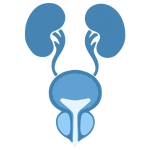Urinary stone disease
Is called the presence of stones anywhere in the urinary tract. Stone formation depends on geographic, climatic, ethnic, dietetic and genetic factors. Areas with warm and humid climate, favor stone formation. In the west world and countries with high living level, the incidence of stone disease is particularly high.
Clinical symptoms depend on whether the stone causes obstruction of the urinary tract or not. In case of obstruction is clinically expressed with renal colic (sharp pain on the flank that reflects towards the inguinal area and the external genitalia). Nausea, vomit and sometimes urination disorders (depending on stone position) are very often. In case of complete obstruction of the upper urinary tract, kidney infection and sepsis is possible. This is a urological emergency and the collecting system must be urgently decompressed. In patients with solitary kidney complete obstruction causes deterioration of kidney function.
Pain relief is the first therapeutic step in patient with acute episode. Sometimes especially when the stone is small and the patient well informed for the possible complications, conservative treatment and follow up is possible. Otherwise, in case of obstruction, risk of infection and impossible or difficult pain relief, kidney decompression and lithotripsy are necessary.
Extracorporeal shockwave lithotripsy (ESWL)
A machine called lithotripter generates shock waves out of the patient’s body. The shock waves, are focused by x-ray or ultrasound on to the kidney or the ureter stone,they travel into the body reaching andcrushing the stone in to small pieces.
It’s a noninvasive very well tolerated procedure. Sometimes the patient may need to receive painkillers or sedation during the treatment. There is no need for hospitalization and the patient is discharged immediately or few hours later. The days after the treatment, small fragments may be eliminated through the urine causing flank pain, haematuria and dysuria. Indications for ESWL depend on stone size and location as well as on patient’s clinical characteristics.
Intracorporeal or endoscopic lithotripsy (reno-ureterolithotripsy)
It is an endoscopic minimally invasive procedure performed under general anaesthesia for the treatment of renal and ureter calculi (stones). The surgeon uses an instrument called ureteroscope (semi rigid or flexible) which is inserted, thanks to an optical fibre under direct view, into the ureter and the renal pelvis. Once the calculi is located is fragmented by the use of holmium laser system. Instruments like small baskets and grasping forceps are then used to remove small stones and fragments. Fluoroscopy also helps to stone localization and better understanding of patient anatomy.Indications for reno-ureterolithotripsy depend on stone size and location as well as on patient’s clinical characteristics.
In case of urinary bladder stones, is performed a procedure called cystolithotripsy. The surgeon uses an instrument called cystoscope which allows the exploration of the bladder and the location of the stones. Once the calculi is located is fragmented by the use of holmium laser system.
Endoscopic lithotripsy is a very well tolerated procedure. After recovery from anaesthesia the patient is discharged and the next day is ready to return to his usual activities.


